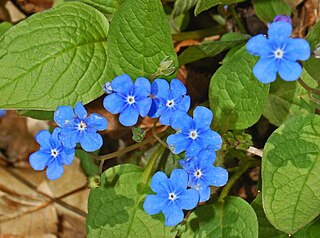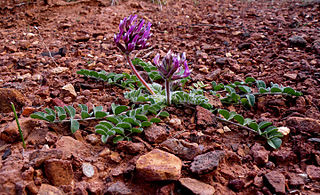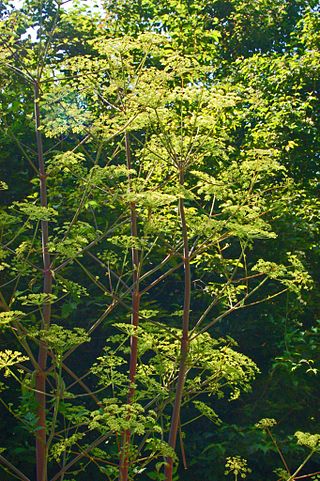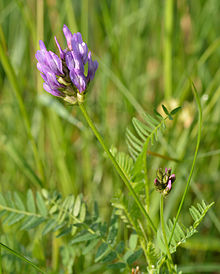
Lathraea (toothwort) is a small genus of five to seven species of flowering plants, native to temperate Europe and Asia. They are parasitic plants on the roots of other plants, and are completely lacking chlorophyll. They are classified in the family Orobanchaceae.

Centaurea scabiosa, or greater knapweed, is a perennial plant of the genus Centaurea. It is native to Europe and bears purple flower heads.

Rhinanthus minor, known as yellow rattle, is a herbaceous wildflower in the genus Rhinanthus in the family Orobanchaceae. It has circumpolar distribution in Europe, Russia, western Asia, and northern North America. An annual plant, yellow rattle grows up to 10–50 centimetres (3.9–19.7 in) tall, with upright stems and opposite, simple leaves. The fruit is a dry capsule, with loose, rattling seeds.

Astragalus is a large genus of over 3,000 species of herbs and small shrubs, belonging to the legume family Fabaceae and the subfamily Faboideae. It is the largest genus of plants in terms of described species. The genus is native to temperate regions of the Northern Hemisphere. Common names include milkvetch, locoweed and goat's-thorn. Some pale-flowered vetches are similar in appearance, but they are more vine-like than Astragalus.

Vicia cracca, is a species of flowering plant in the pea and bean family Fabaceae. It is native to Europe and Asia. It occurs on other continents as an introduced species, including North America, where it is a common weed. It often occurs in disturbed habitats, including old fields and roadside ditches.

Omphalodes verna, the creeping navelwort or blue-eyed-Mary, is a rhizomatous herbaceous perennial plant in the genus Omphalodes belonging to the family Boraginaceae.

Vicia sepium or bush vetch is a species of flowering plant in the pea and bean family Fabaceae. A nitrogen-fixing, perennial, leguminous climbing plant that grows in hedgerows, grasslands, the edges of woodland, roadsides and rough ground. It occurs in western Europe, Crimea of Ukraine, Russia including Siberia, Caucasus and Central Asia. It can also be found in eastern Canada, north-eastern states of the USA and, where suitable habitat occurs, in Greenland. It is native to, and has been recorded in, almost all parts of Britain, Ireland and associated islands.

Vicia sylvatica, known as wood vetch, is a species of flowering plant in the bean family Fabaceae. It was described by Carl Linnaeus.
NVC community CG3 is one of the calcicolous grassland communities in the British National Vegetation Classification system. It is one of four communities of rank, tussocky grassland associated with low levels of grazing, within the lowland calcicolous grassland group.
NVC community CG4 is one of the calcicolous grassland communities in the British National Vegetation Classification system. It is one of four communities of rank, tussocky grassland associated with low levels of grazing, within the lowland calcicolous grassland group.

Astragalus trichopodus is a species of legume known by the common name Santa Barbara milk vetch. It is native to southern California and Baja California, where it grows in several types of open habitat, including in the Transverse Ranges and Mojave Desert.

Astragalus jaegerianus is a rare species of milkvetch known by the common name Lane Mountain milkvetch. The plant was named for the biologist Edmund Jaeger, who first documented it in 1939.

Oenanthe pimpinelloides is a species of flowering plant in the family Apiaceae known by the common name corky-fruited water-dropwort. It is a plant of damp or dry grassland and more ruderal tall herb communities.

Astragalus holmgreniorum is a rare species of milkvetch known by the common names Holmgren milk-vetch and paradox milk-vetch. It is native to a tiny section of desert shrub woodland on the border between Utah and Arizona, in the far northern Mojave Desert. There are six populations remaining. It is a federally listed endangered species.

Scilla bifolia, the alpine squill or two-leaf squill, is a herbaceous perennial plant growing from an underground bulb, belonging to the genus Scilla of the family Asparagaceae.

Peucedanum verticillare, common name giant hog fennel or milk parsley, is a herbaceous plant in the genus Peucedanum of the family Apiaceae.

Lithospermum purpurocaeruleum is a synonym for Aegonychon purpurocaeruleum (L.) Holub, also known as the purple gromwell, This plant is a herbaceous perennial rhizomatous flowering plant and it belongs to the family Boraginaceae.

Astragalus drummondii is a species of flowering plant in the legume family known by the common name Drummond's milkvetch. The botanist Thomas Drummond first identified the plant during his travels in North America from 1825 to 1835, the year of his death. Astragalus drummondii is one of many plants named after him. Upon the return of samples collected by Drummond to England, his findings were published in Sir William Hooker’s Flora Boreali-Americana in 1840.

Astragalus crassicarpus, known as ground plum or buffalo plum, is a perennial species of flowering plant in the legume family, Fabaceae, native to North America. It was described in 1813. The fruit is edible and was used by Native Americans as food and horse medicine. It is a host of afranius duskywing larvae. It is also known as groundplum milkvetch and pomme de prairie.

Hedbergia is a monotypic genus of flowering plants, initially classified in Scrophulariaceae, and now within the broomrape family Orobanchaceae. It contains a unique species, Hedbergia abyssinica. It is an afromontane genus, widespread in grasslands and scrubs of the mountains of tropical Africa, and known from Ethiopia, Zaire, Uganda, Kenya, Tanzania, Malawi, Nigeria, and Cameroons.



















